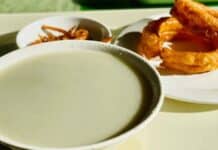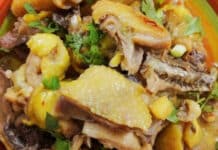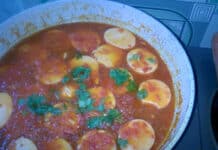Every year, as Tet approaches, families across Vietnam, especially in the North, prepare and feast on Banh Chung – a traditional sticky rice cake. This delicious treat has become an integral part of the festive season, with its preparation and consumption signifying the arrival of spring.
Banh Chung is a must-have dish during Tet, and families often make dozens of these cakes. Some are offered to ancestors during rituals, while others are given as gifts or served during family gatherings.
The legend of Lang Lieu and his creation of Banh Chung and Banh Day is well-known among students. It inspires families to come together and make these delicious treats during Tet.

What is Banh Chung?
Banh Chung is a square-shaped cake that symbolizes the earth, while its companion, Banh Day, is round and represents the sun. As a country with a strong agrarian culture, Vietnam has long depended on natural elements for its livelihood. Thus, Banh Chung has become an essential offering to express gratitude to the heavens for a bountiful harvest.
The act of making Banh Chung during Tet also symbolizes filial piety. This custom of offering Banh Chung to one’s parents is a way of expressing gratitude for their love and care.
2. Ingredients for Banh Chung
Preparing delicious Banh Chung requires specific ingredients and techniques. The quality of the ingredients plays a crucial role in determining the taste and texture of the final product.
2.1. Selecting Dong Leaves
Dong leaves are essential for wrapping Banh Chung. Choose leaves that are neither too big nor too small. They should be fresh, dark green, and have small stems. Clean the leaves thoroughly and dry them in a well-ventilated area. Avoid over-drying or leaving them too damp.
2.2. Choosing Glutinous Rice
For Banh Chung, use glutinous rice with shiny, evenly sized grains. Soak the rice in cold water for 10-12 hours, then rinse and drain. Add a moderate amount of salt to enhance the flavor.
The distinctive taste of Banh Chung comes from the combination of salty rice, fragrant mung beans, and fatty pork. Therefore, adjust the amount of salt accordingly to balance the flavors of the rice, beans, and meat.
If you want to enhance the aroma and color of the rice, you can use ground young rice leaves mixed with water to soak the glutinous rice before cooking.
2.3. Choosing Mung Beans
Mung beans are the heart of Banh Chung. You can easily find peeled or unpeeled beans in the market. If using unpeeled beans, soak them, remove the peels, and sift to get rid of any remaining shells. Although it’s a time-consuming process, using unpeeled beans adds a unique flavor and aroma to the dish.
2.4. Binding Strings
These strings are used to secure the Banh Chung. Choose giang (a type of vine) sticks that are 70-90 cm long, peel the outer layer, and split them into even strips. Soak the sticks before splitting to make them softer and easier to work with. Dry the strips after splitting for a firmer grip when tying the cakes.
Using these binding strings ensures that the Banh Chung is securely tied while maintaining a certain level of flexibility.
2.5. Meat and Spices
The final ingredients are meat and spices. For the filling, use a combination of fatty and lean pork belly. The fat adds a savory taste, while the lean meat brings good luck for the new year. Season the meat with a moderate amount of spices and a pinch of black pepper for a subtle spicy kick.
3. Step-by-Step Guide to Wrapping Banh Chung
Preparing the Filling and Dong Leaves
- Soak the mung beans for about 2 hours until they soften. Drain and discard any discolored beans. Add a teaspoon of salt, mix well, and steam the beans until cooked. While still hot, use a spoon to mash the beans into a smooth paste and form them into balls. Note: You can also use raw soaked beans mixed with salt for the filling.
- Clean the pork belly and cut it into thick slices, about 2 cm thick. Marinate the meat with spices and a touch of black pepper to enhance the flavor and add a subtle spiciness.
- Soak the glutinous rice for about 2 hours before wrapping. Drain and mix with salt, ensuring that the amount of salt is just right to avoid oversalting or making the cakes too bland.
- If you want to add a green color and enhance the aroma of the rice, you can use ground young rice leaves mixed with water to soak the glutinous rice before cooking.
- Clean the dong leaves thoroughly on both sides and dry them in a cool, well-ventilated area. Use a knife or scissors to separate the leaves from the stems. A helpful tip for cutting close to the leaves without tearing them is to start from the middle and work your way back to the stem.

3.1. Method 1: Wrapping Banh Chung Without a Mold in a Cross Shape

Step 1: Place two leaves perpendicular to each other, with the glossy side facing down. Then, place two more leaves on top, also perpendicular to each other, but with the glossy side facing up.

Step 2: Place a small bowl of rice in the center of the leaves.


Step 3: Add the prepared mung bean paste (or a large spoonful of raw soaked mung beans) on top of the rice. Place 1-2 slices of marinated pork belly on top, followed by another layer of mung beans, and finally, cover with another bowl of rice to completely enclose the filling.




Step 4: Fold the left and right sides of the leaves inward, making sure to tuck in any excess leaves. If there is too much excess, you can trim it with scissors.
Step 5: Using your thumbs, press the top leaves inward, and then fold them over while holding the previously folded leaves in place with your thumbs. Repeat this process on the other side.
Step 6: Once the cake is formed, use four strings to secure it. Tuck in the excess string neatly. Alternatively, you can place the four strings underneath the leaves from the beginning to prevent the cake from shifting during the tying process.

After completing these steps, gently press down on the cake with your palms to ensure it is tightly packed.
3.2. Method 2: Wrapping Banh Chung Using a Mold

Step 1: Place four dong leaves in the same arrangement as in Method 1, with two leaves facing glossy side down and the other two facing up. Place an inner mold upside down in the center of the leaves.

Step 2: Wrap the mold with the leaves in the same way as in Method 1. Refer to the illustrative images for a detailed guide.

Step 3: Once the leaves are folded into a square shape, place the outer mold around the inner mold and open the leaves to remove the inner mold.

Step 4: Fill the leaf-mold with ingredients in layers. Start with a layer of glutinous rice spread evenly across the mold, followed by mung beans, marinated meat, another layer of mung beans, and finally, a layer of rice to completely cover the filling. Fold the leaves neatly and tightly, following the existing creases.

Step 5: After filling and wrapping the cake, hold the leaves in place with one hand and gently remove the mold with the other. Secure the cake with four strings, tucking in the excess string neatly. This ensures that the cake remains compact and well-shaped.
3.3. Method 3: Wrapping Banh Chung Without a Mold in a Square Shape
Step 1: Folding the Dong Leaves into a Square Shape
- Choose the darkest side of the leaf to be the outer surface of the cake.
- Fold the leaf in half along the leaf vein to create a crease.
- From the middle of one side of the leaf, fold it diagonally toward the leaf vein so that it touches the edge of the vein, forming one corner of a square shape.
- Repeat this process with the three remaining leaves.

Step 2: Creating a Banh Chung Mold with Folded Dong Leaves
- Place the second leaf on top of the first, aligning the bottom edges symmetrically.
- Place the third leaf on top, with its bottom edge parallel to the first leaf and symmetrical to the second leaf.
- Finally, place the fourth leaf on top, with its bottom edge symmetrical to the third leaf.
- This completes half of the square mold for the cake.

Step 3: Filling the Dong Leaf Mold
- Start by spreading a layer of glutinous rice evenly across the bottom of the mold.
- Add a layer of mung beans on top of the rice.
- Place several slices of marinated meat on top.
- Finally, cover with another layer of glutinous rice to completely enclose the filling.

Step 4: Wrapping Banh Chung with Folded Dong Leaves
- Place a string at the bottom of the mold to secure it.
- Pull and press the two parallel sides of the folded leaf toward each other, forming two pointed corners.
- Secure the string in place.
- Fold the two pointed corners inward, ensuring they are even and tightly packed.
- Take the middle string and wrap it around the folded corners to hold them in place, tucking the knot underneath the string to secure it.

Step 5: Tying the Strings to Secure the Banh Chung
- Wrap the second string around the cake, perpendicular to the first string. Tuck the knot underneath the first string to secure it.
- Continue tying the strings tightly, ensuring that the knots are tucked underneath the previous string.

- Once you’ve completed the above steps, place the cakes in a pot.
- Add enough water to cover the cakes.

- Cover the pot and weigh down the lid with a heavy object to prevent the cakes from floating. Boil the cakes over medium heat, checking the water level every hour. Once cooked, you can enjoy your delicious Banh Chung!
Good luck, and happy cooking!
Web design and development expert with over 15 years of experience. I have successfully helped hundreds of businesses develop comprehensive web development plans to create sustainable and profitable websites.































